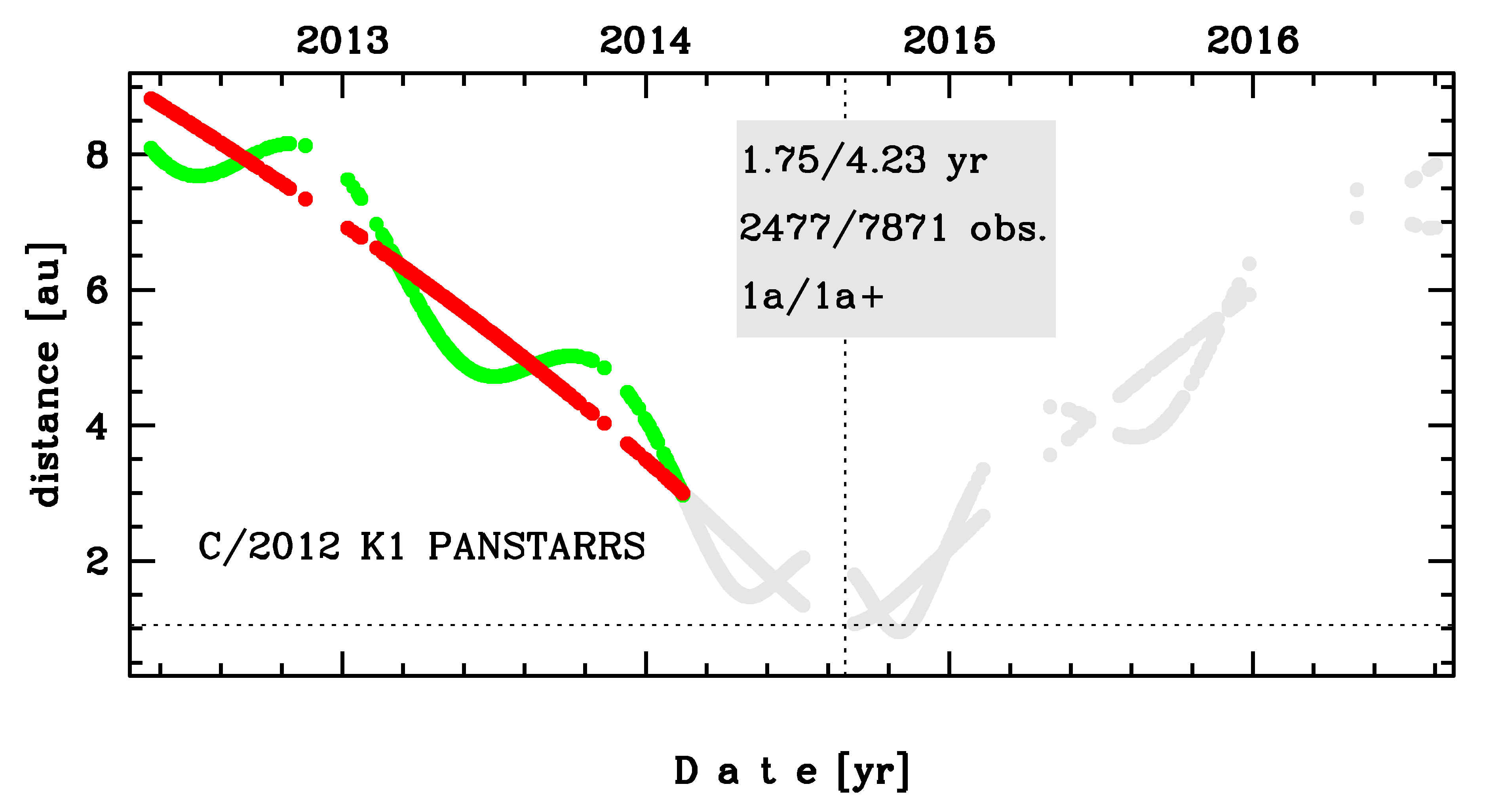C/2012 K1 PANSTARRS
more info
Comet C/2012 K1 was discovered on 19 May 2012 with Pan-STARRS 1 telescope (Haleakala), that is more than 2 years before its perihelion passage. Later a few pre-discovery images were found taken on 14 May ( MASTER-II Observatory, Tunka) and 17 May (Pan-STARRS 1). It was almost systematically observed until 7 August 2016 (see picture).
C/2012 K1 had its closest approach to the Earth on 31 October 2014 (0.953 au), about 2 months after its perihelion passage.
Preferred solution given here is based on data spanning over 4.23 yr in a range of heliocentric distances: 8.83 au – 1.055 au (perihelion) – 7.85 au.
This Oort spike comet suffers small planetary perturbations during its passage through the planetary system that cause a bit tighter future orbit (see future barycentric orbits).
See also Królikowska 2020.
C/2012 K1 had its closest approach to the Earth on 31 October 2014 (0.953 au), about 2 months after its perihelion passage.
Preferred solution given here is based on data spanning over 4.23 yr in a range of heliocentric distances: 8.83 au – 1.055 au (perihelion) – 7.85 au.
This Oort spike comet suffers small planetary perturbations during its passage through the planetary system that cause a bit tighter future orbit (see future barycentric orbits).
See also Królikowska 2020.
| solution description | ||
|---|---|---|
| number of observations | 2477 | |
| data interval | 2012 05 14 – 2014 02 13 | |
| data arc selection | data generally limited to pre-perihelion (PRE) | |
| range of heliocentric distances | 8.83 au – 3au | |
| detectability of NG effects in the comet's motion | comet with NG effects strongly manifested in positional data fitting | |
| type of model of motion | GR - gravitational orbit | |
| data weighting | YES | |
| number of residuals | 4919 | |
| RMS [arcseconds] | 0.34 | |
| orbit quality class | 1a | |
| previous orbit statistics, both Galactic and stellar perturbations were taken into account | ||
|---|---|---|
| no. of returning VCs in the swarm | 5001 | * |
| no. of escaping VCs in the swarm | 0 | |
| no. of hyperbolas among escaping VCs in the swarm | 0 | |
| previous reciprocal semi-major axis [10-6 au-1] | 23.30 – 26.17 – 27.11 | |
| previous perihelion distance [au] | 2200 – 2600 – 3000 | |
| previous aphelion distance [103 au] | 71.6 – 73.8 – 82.9 | |
| time interval to previous perihelion [Myr] | 7.32 – 7.72 – 8.11 | |
| percentage of VCs with qprev > 20 | 100 | |
| previous_g orbit statistics, here only the Galactic tide has been included | ||
|---|---|---|
| no. of returning VCs in the swarm | 5001 | * |
| no. of escaping VCs in the swarm | 0 | |
| no. of hyperbolas among escaping VCs in the swarm | 0 | |
| previous reciprocal semi-major axis [10-6 au-1] | 25.21 – 26.06 – 26.92 | |
| previous perihelion distance [au] | 18 – 23 – 30 | |
| previous aphelion distance [103 au] | 74.3 – 76.7 – 79.3 | |
| time interval to previous perihelion [Myr] | 7.16 – 7.52 – 7.91 | |
| percentage of VCs with 10 < qprev < 20 | 27 | |
| percentage of VCs with qprev > 20 | 73 | |
